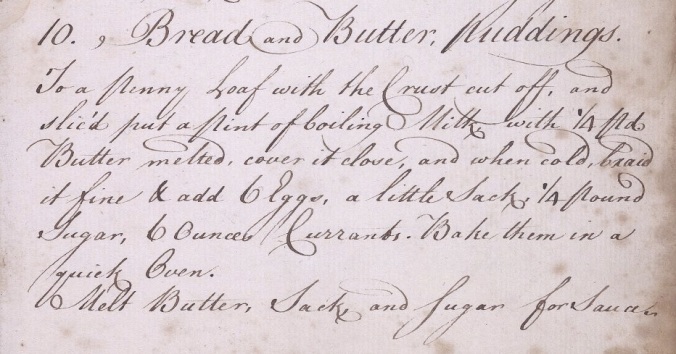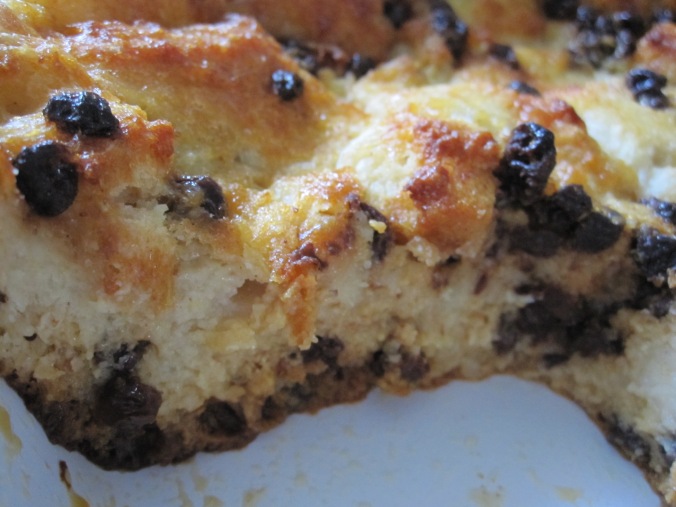Reunited in the kitchen! Marissa has returned to Philadelphia from the west coast, and we’re cooking together again. (Yay.)
Many early modern recipes provide intriguing experiments – I made portugal cakes because I couldn’t quite imagine what they’d taste like (delicious), for instance, and artificial potatoes because I wondered if they’d look like actual potatoes (maybe/sort of). Some recipes we try end up with a taste surprisingly similar to familiar modern recipes, like the snickerdoodle-esque shrewsbury cakes. But with a few exceptions like one of our earliest and tastiest experiments, maccarony cheese, we don’t often come across recipes with an immediately apparent modern counterpart. Therefore, when I was leafing through my recent favorite, MS Codex 205, and spotted the recipe for Bread and Butter Puddings, it went straight to the top of my to-try list. We both love bread pudding (and bread generally), so this version from the 1770s or 80s seemed like a great way to celebrate cooking in the same place once more.
The Recipe
10. Bread and Butter Puddings
To a Penny Loaf with the Crust cut off, and
slic’d put a Pint of boiling Milk, with 1/4 Pd.
Butter melted, cover it close, and when cold, braid
it fine & add 6 Eggs, a little Sack, 1/4 Pound
Sugar, 6 Ounces Currants. Bake them in a
quick Oven.
Melt Butter, Sack, and Sugar for Sauce.
Our Recipe
This is a fairly straightforward recipe: all of the ingredients are readily available (substitute raisins if you can’t find currants), the instructions are clear, and most of the measurements are precise. One direction brought us up short: to “braid” the soaked bread mixture. Braid it? I can’t even manage a french braid, let alone bread that has been soaking in milk and butter for a few hours! I’m glad that we went to the OED before attempting a hilariously messy plait: the dictionary suggests that “braid” could be a corruption of “bray” (“to beat small”). We interpreted this as cutting the soaked bread into smaller pieces. (Though why the dry bread couldn’t just be cut into smaller pieces before soaking is unclear.) The other interpretation would be to layer the soaked bread tightly before adding the egg mixture, perhaps because the slices were soaked in a single layer? But we’d already layered the bread before soaking it. But really, however you cut it and/or layer it, the bread will soak up the milk and egg mixtures and bake together into a delicious final product.
10-14 slices commercial white bread (14-20 oz. any bread), crusts removed*
1/4 lb. (1 stick) butter, melted
1 pint (2 c.) milk
6 oz. (1 1/2 c.) currants
4 oz. (heaping 1/2 c.) sugar
6 eggs
1/4 c. white wine
Arrange bread in a pyrex or other heatproof container – tear some of the slices in half to make them fit more closely. (You’ll be cutting the bread up more finely and transferring it to a baking dish, so don’t worry too much about careful arrangement.) Heat the milk just until bubbles form at the edges, add the melted butter, and pour over the bread. Gently press down on the top layer of bread with a fork to make sure it is evenly saturated. Cover container and set aside to cool to room temperature. (I hurried this step along by cooling it slightly and then transferring it to the fridge.)
Once bread mixture has cooled and the liquid has been mostly absorbed, cut the bread into smaller pieces by making an X motion with two table knives, just as you’d cut butter into pastry dough. Combine wine, eggs, and sugar and whisk lightly. Pour over bread mixture and add currants, then stir until everything is evenly distributed.
Heat oven to 350F. Transfer bread mixture to a well-greased 9×13″ baking dish** and bake for 60-70 mins., until puffed and golden brown. Cool on a wire rack and serve warm or at room temp.***
*Note: Determining how much bread to use was a little tricky. The early modern penny loaf was a small loaf of bread that cost – you guessed it – a penny, but the size of the loaf varied based on the cost of flour. So, based on the amount of liquid the recipe called for and by comparing it to modern bread pudding recipes, we used 10 slices of a commercial loaf of white bread. (We chose this because it was easy to pick up while we were getting the other ingredients; other bakery breads would also be great.) Before removing the crusts, the 10 slices weighed 14 oz. This amount of bread made for a delicious but very, very wet bread pudding; we agreed that another few slices would have made a good difference in texture. So, you could use anywhere from 14 to 18 or even 20 oz. bread (before removing the crusts), depending on what texture you prefer. There’s enough liquid that 20 oz. of bread should work; more than this might make for an overly dry pudding. And if you can plan ahead and use slightly stale bread, it will absorb the liquid even better.
**Note: We tried baking this in a 9″ pie dish but had to remove some of the mixture into two ramekins and bake them separately to avoid overflow. A larger baking dish avoids this problem. You could also distribute the bread mixture into ramekins or other smaller baking dishes: the ramekins did bake up adorably.
***Note: While the original does call for a sauce of butter, wine, and sugar, the bread pudding was so moist and rich that we didn’t feel like it needed the enhancement. If you’re feeling particularly decadent, however, by all means add the sauce!
The Results
It’s bread pudding. And therefore awesome. Need I say more? (I’m partial.) The white wine adds a slight tang to the milkiness, and the currants provide sweetness that isn’t overbearing. It’s good the day of baking (once cooled a bit) and as leftovers, too.
We sprinkled in some cinnamon because we like it. You could also add nutmeg, a little ginger, a splash of vanilla, some orange zest – whatever flavors you enjoy.







You must be logged in to post a comment.